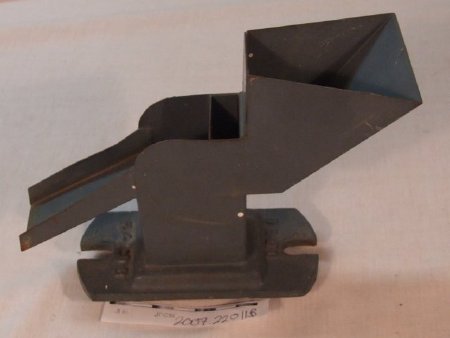Collection:
Juneau—Douglas City Museum
Object ID:
2007.22.011AB
Accession#:
2007.22
Credit Line:
Transferred from the U.S. Bureau of Land Management.
Object Name:
Separator, Jigging—machine
Title:
Ore Concentrator Jig
Year Range from:
1950
Year Range to:
1996
Description:
Mineral Jig, Ore Concentrator ,Ore Concentrator Jig or Hydraulic Jig.
A Concentrator
The different components of this concentrator are all mounted to a base made of wood. The entire thing is painted green. On the proper right is an electric motor manufactured by General Electric, with a manufactures name plate on its back side. This motor has a power cord coming out of the back. The motor is attached to a wheel with a drive belt. This wheel runs the hydraulic pump at center. On the center of the wheel is an arrow that points in a clock—wise direction, and the word "ROTATION." On the proper left is a sieve. This sieve is mounted to a cast iron bowl. On the back is a valve which helps the operator to regulate the flow of water into the system.
B: Sieve Attachment
Gray metal attachment. In front there is a loader for material. This leads to a metal grating (at the bottom). At the back there is a metal shoot. The base of the sieve has two slots in it for screws. "DECO / H470B" is written on the bottom.
Used to load material into the Concentrator.
A Concentrator
The different components of this concentrator are all mounted to a base made of wood. The entire thing is painted green. On the proper right is an electric motor manufactured by General Electric, with a manufactures name plate on its back side. This motor has a power cord coming out of the back. The motor is attached to a wheel with a drive belt. This wheel runs the hydraulic pump at center. On the center of the wheel is an arrow that points in a clock—wise direction, and the word "ROTATION." On the proper left is a sieve. This sieve is mounted to a cast iron bowl. On the back is a valve which helps the operator to regulate the flow of water into the system.
B: Sieve Attachment
Gray metal attachment. In front there is a loader for material. This leads to a metal grating (at the bottom). At the back there is a metal shoot. The base of the sieve has two slots in it for screws. "DECO / H470B" is written on the bottom.
Used to load material into the Concentrator.
Notes:
This is an ore concentrator. It is used to physically separate the mineral components of a course sand ore based on the specific gravity of each component. The use of jigs such as this declined as floatation processes were developed and are now rarely used, except at small, remote mines. The work of hydraulic jigs depends upon the action of two currents of water, an upward and a downward current, alternating with each other in quick succession, upon a bed of sand supported by a screen. With sands of two or more specific gravities, during the upward movement, called "pulsion," arrange themselveds into layers through settling. During the downward movement, called "suction," small grains move downward through the spaces bewteen the larger grains. In a continous jigs there is also a surface carrying current, which serves to transport lighter grains forward until they are discharged over the tail of the sieve; sometimes this is done by a mechanical device.
There are two classes of jigs, jigs with movable sieves, which obtain the currents by moving the sieve up and down in the water; and jigs with with fixed sieves, in which the currents are produced either by a plunger or by a stream of hydraulic water brought into the space beneath the sieve. This is a fixed sieve jig. This type was far more common. They do not work well with fine—grained material. The products of a jig are designated as: 1)tailings, which form the top layer and are either skimmed off the top intermittently by hand, or carried over the tail board continuously by the carrying current; 2) coarse concentrate, which forms the heavy or lower layer in the sieve, and is composed of grains too coarse to pass through the sieve; or 3) hutch, fine concentrate which is the part that passes through the sieve and comes out the bottom.
There are two classes of jigs, jigs with movable sieves, which obtain the currents by moving the sieve up and down in the water; and jigs with with fixed sieves, in which the currents are produced either by a plunger or by a stream of hydraulic water brought into the space beneath the sieve. This is a fixed sieve jig. This type was far more common. They do not work well with fine—grained material. The products of a jig are designated as: 1)tailings, which form the top layer and are either skimmed off the top intermittently by hand, or carried over the tail board continuously by the carrying current; 2) coarse concentrate, which forms the heavy or lower layer in the sieve, and is composed of grains too coarse to pass through the sieve; or 3) hutch, fine concentrate which is the part that passes through the sieve and comes out the bottom.
Search Terms:
Mining
Assaying
T&E
JMIC
Assaying
T&E
JMIC


